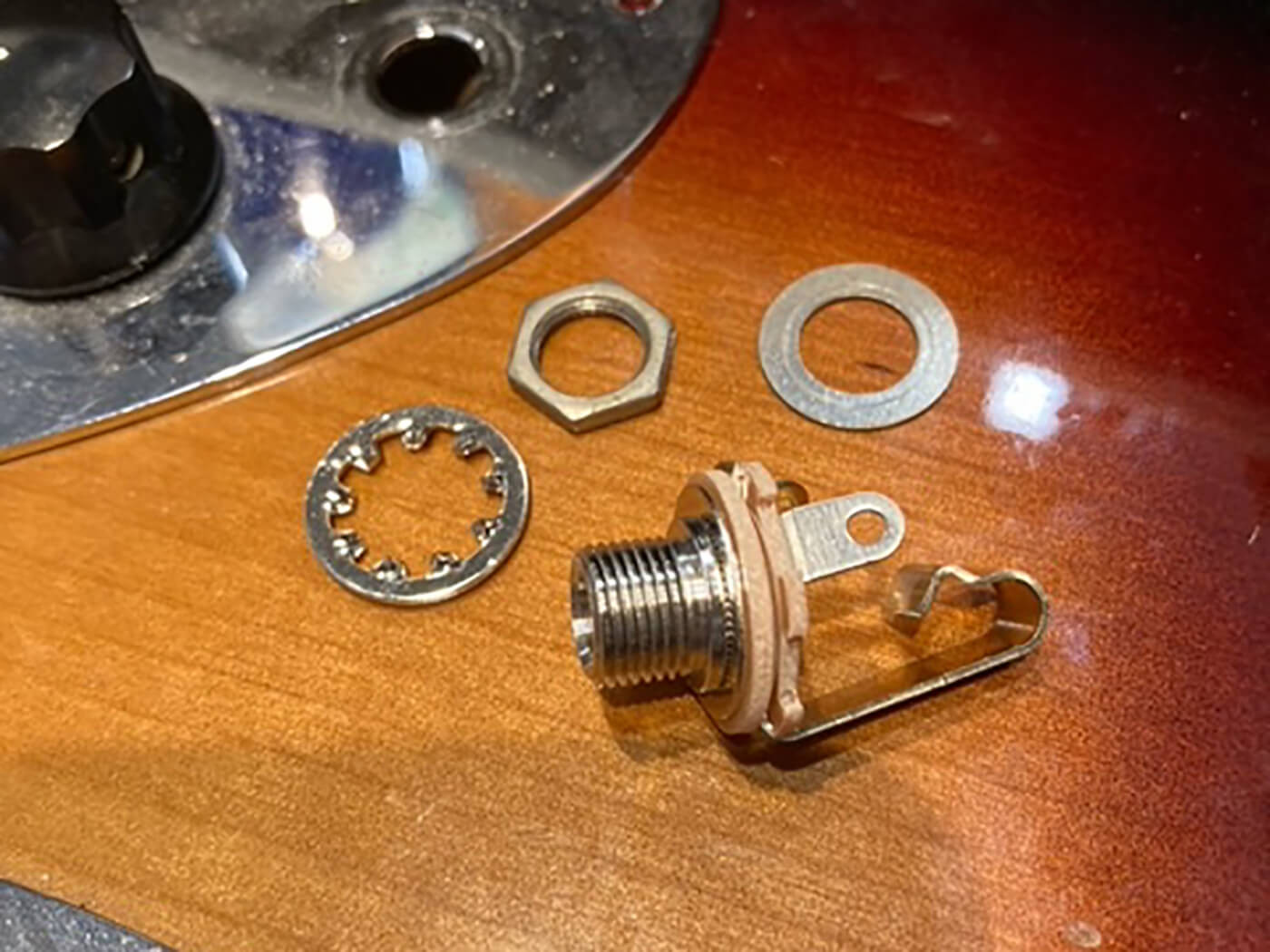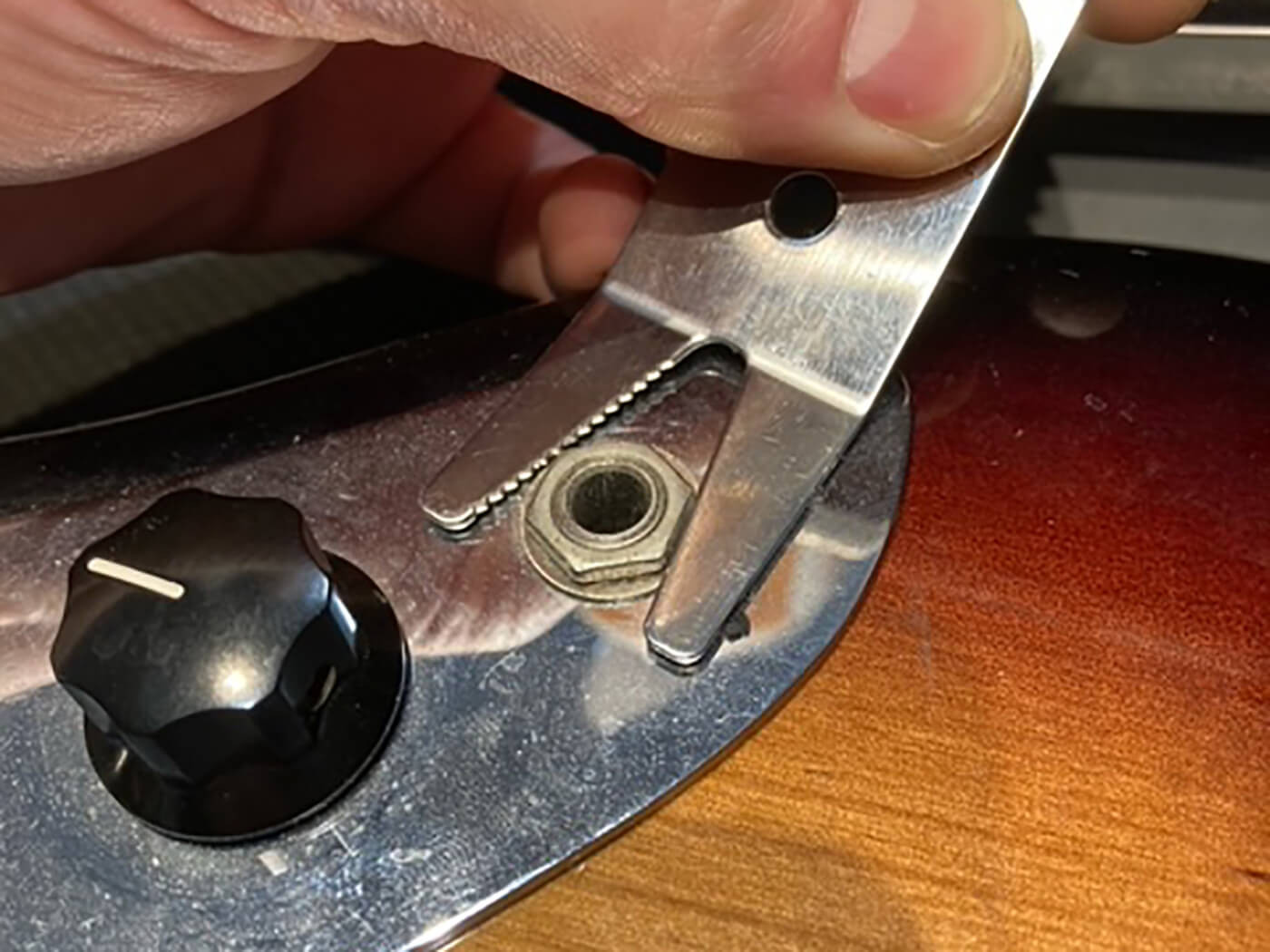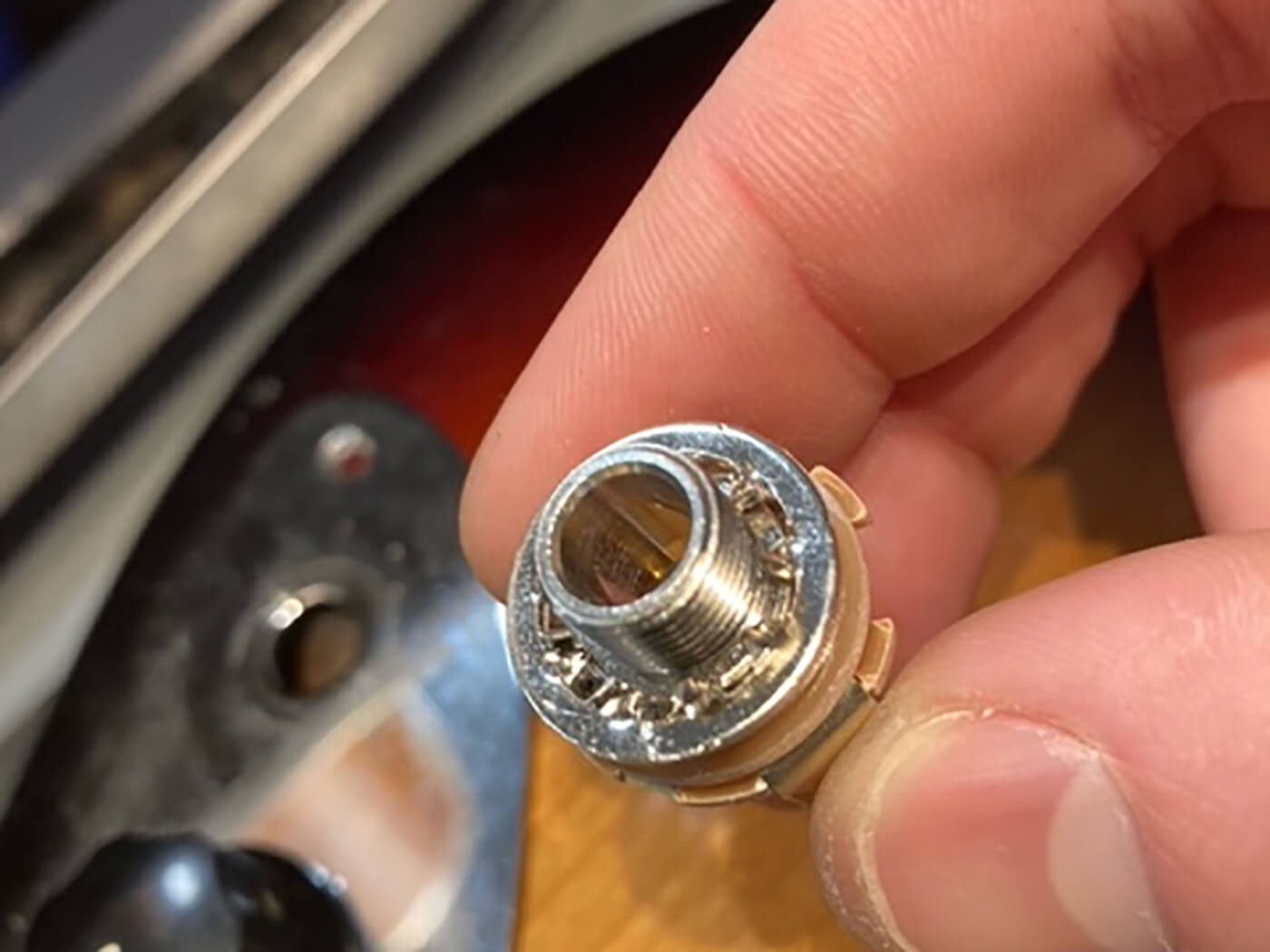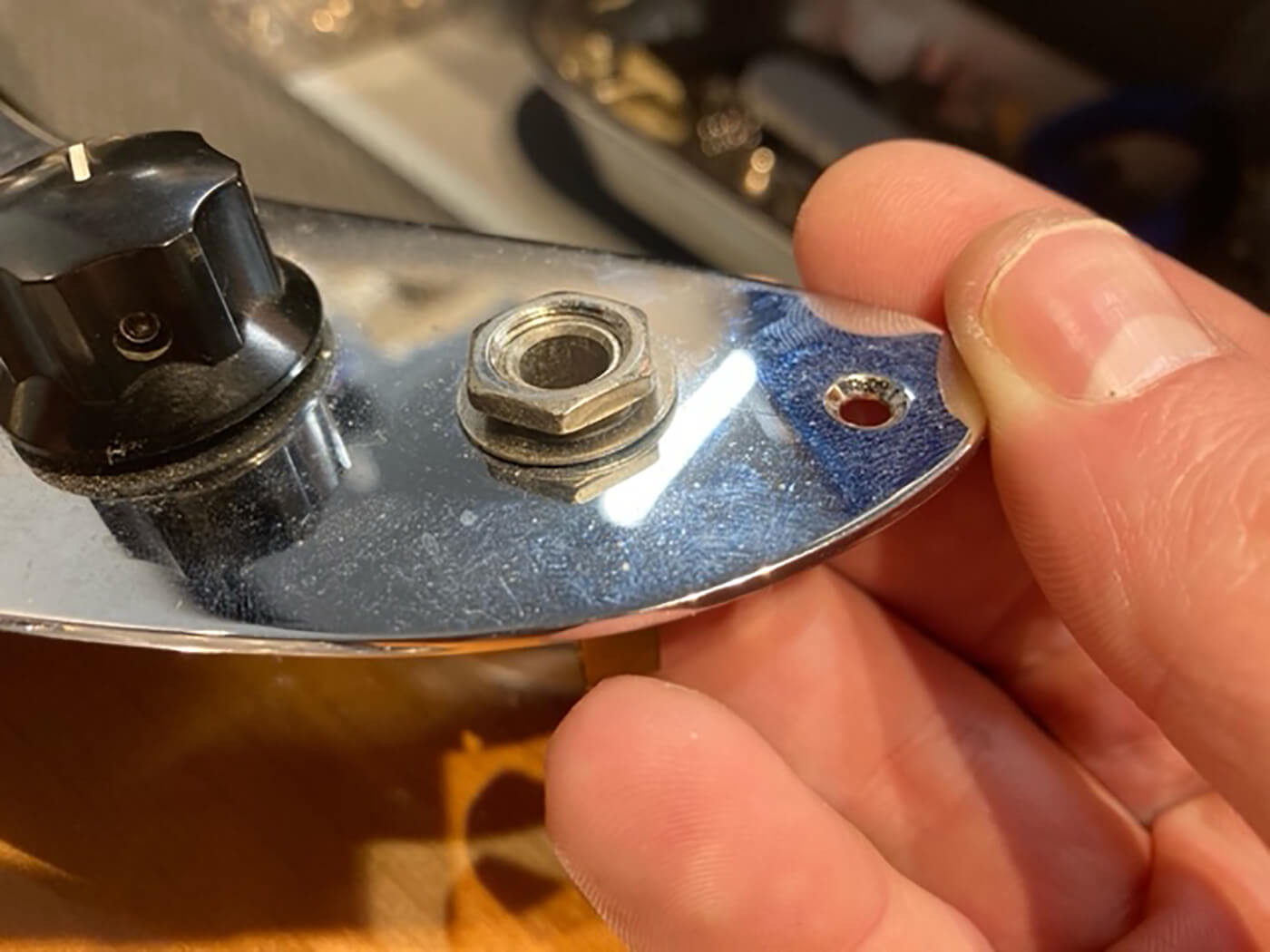Is your guitar’s output jack crackling, cutting out, or just plain not working? Fixing a guitar jack socket can seem daunting, but with the right guidance, you can get your axe singing again! This comprehensive guide from guitarplayers.net will walk you through the process, ensuring your guitar is ready to rock in no time with clear instruction and helpful tips.
1. What Causes a Guitar Jack Socket to Fail?
A guitar jack socket can fail due to several reasons, with wear and tear being the most common. The good news is, according to research from the Berklee College of Music, in July 2025, preventative maintenance such as routine cleaning can drastically reduce the potential for failure.
Here’s a breakdown:
- Loose Connections: Constant plugging and unplugging can loosen the internal connections of the jack.
- Corrosion: Exposure to moisture and air can cause corrosion on the metal parts, leading to poor signal transmission.
- Physical Damage: Accidental impacts or stress on the cable can physically damage the jack.
- Cheap Components: As seen in many guitars manufactured outside the US and UK, lower-quality jack sockets use cheaper materials that are more prone to failure.
- Solder Joint Failure: Over time, the solder joints connecting the wires to the jack can weaken and crack, interrupting the signal path.
2. What Tools Do I Need to Fix a Guitar Jack Socket?
Having the right tools is essential for a successful repair. These tools aren’t just about fixing the problem; they’re about ensuring the longevity and quality of your guitar’s sound, according to a study by Guitar Player Magazine in March 2024.
Here’s a list of essential tools:
- Soldering Iron: A temperature-controlled soldering iron is ideal for precise soldering.
- Solder: Use rosin-core solder specifically designed for electronics.
- Wire Strippers: For stripping the insulation off the wires without damaging them.
- Needle-Nose Pliers: To help manipulate wires and components in tight spaces.
- Screwdrivers: A set of screwdrivers to remove the jack plate and access the wiring.
- Multimeter: To test continuity and identify any shorts in the circuit.
- Jack Socket Wrench or Nut Driver: To tighten or loosen the nut securing the jack socket.
- Helping Hand Tool: An articulated clip and base, will help when soldering.
- Solder Sucker/Braid: Will help remove unwanted solder.
3. How Do I Diagnose a Faulty Guitar Jack Socket?
Before diving into the repair, accurately diagnosing the problem is crucial. According to Guitar World’s “Guitar Maintenance Handbook,” effective troubleshooting saves time and prevents unnecessary repairs.
Follow these steps to diagnose the issue:
- Test with Different Cables: Use a different guitar cable to rule out a faulty cable.
- Try a Different Guitar/Amp: Plug your guitar into a different amplifier and use a different guitar with your amp to isolate the problem.
- Inspect the Jack Socket: Look for any visible damage, loose connections, or corrosion.
- Check the Wiring: Ensure that the wires are securely connected to the jack terminals.
- Use a Multimeter: Test the continuity between the terminals to identify any shorts or open circuits.
- Wiggle the Cable: While the guitar is plugged in, gently wiggle the cable at the jack. If the sound cuts in and out, it indicates a loose connection.
4. How to Replace a Guitar Jack Socket: A Step-by-Step Guide
Replacing a guitar jack socket is a straightforward process that any guitarist can accomplish with the right tools and a bit of patience.
 DIY Workshop – Fixing a faulty jack socket
DIY Workshop – Fixing a faulty jack socket
Here’s a detailed guide:
- Gather Your Tools: Make sure you have all the necessary tools and a replacement jack socket. Consider using a high-quality Switchcraft jack for improved reliability.
- Remove the Jack Plate: Use a screwdriver to remove the screws holding the jack plate in place. Gently pull out the jack socket.
- Observe the Wiring: Take a close look at how the wires are connected to the old jack. It’s helpful to take a picture or draw a diagram for reference.
- Desolder the Wires: Heat the solder joint on each terminal and gently pull the wire off. A solder sucker or solder wick can help remove excess solder.
- Prepare the New Jack: If necessary, tin the terminals of the new jack socket with a small amount of solder. This will make it easier to solder the wires.
- Solder the Wires: Connect the wires to the corresponding terminals on the new jack. Ensure that the solder joints are clean and secure. Typically, the ground wire (usually black) connects to the sleeve terminal, and the hot wire (usually white or colored) connects to the tip terminal.
 DIY Workshop – Fixing a faulty jack socket
DIY Workshop – Fixing a faulty jack socket - Test the Connection: Before reassembling, plug in your guitar and tap the pickups to check if the signal is coming through. If you hear a loud buzz, the wires may be reversed.
- Reassemble the Jack Plate: Carefully place the jack socket back into the jack plate and secure it with the screws.
- Final Test: Plug in your guitar and play to ensure that the jack socket is working correctly.
5. How To Solder a Guitar Jack Socket Like A Pro
Soldering might seem intimidating, but with a few tips, you can achieve professional-quality solder joints. A solid solder connection is the bedrock of a well-maintained guitar, according to experts at Fender.
 DIY Workshop – Fixing a faulty jack socket
DIY Workshop – Fixing a faulty jack socket
Here are some tips:
- Cleanliness is Key: Make sure the terminals and wires are clean and free of any dirt or corrosion.
- Heat the Joint, Not the Solder: Apply the soldering iron to the terminal and wire simultaneously, then touch the solder to the heated joint.
- Use Enough Solder: Apply enough solder to create a solid connection, but avoid using too much, which can cause shorts.
- Let it Cool: Allow the solder joint to cool naturally without blowing on it or moving the wires.
- Inspect the Joint: A good solder joint should be shiny and smooth. If it looks dull or grainy, it may be a cold solder joint, which needs to be reheated.
6. What Are Common Guitar Jack Wiring Diagrams?
Understanding the different wiring diagrams for guitar jacks can help you troubleshoot and repair your guitar with confidence.
Here are a few common configurations:
- Standard Mono Jack: This is the most common type, used in most electric guitars. It has two terminals: one for the ground (sleeve) and one for the hot signal (tip).
- Stereo Jack: Used for guitars with stereo outputs or for switching functions. It has three terminals: ground, tip (left channel), and ring (right channel or switch).
- Active Circuit Jack: Guitars with active pickups or onboard preamps may have a third terminal that acts as an on-off switch for the battery.
 DIY Workshop – Fixing a faulty jack socket
DIY Workshop – Fixing a faulty jack socket
7. How Do I Troubleshoot Common Guitar Jack Problems?
Even with careful repair, issues can still arise. Here’s how to troubleshoot common problems:
- No Sound: Check all connections, ensure the wires are soldered correctly, and test the jack with a multimeter.
- Crackling or Static: This usually indicates a loose connection or dirty jack. Clean the jack with contact cleaner and check the solder joints.
- Hum or Buzz: This can be caused by a ground loop or poor grounding. Ensure that the ground wire is securely connected to the jack and the guitar’s ground.
- Weak Signal: This could be due to a corroded jack or a faulty component. Replace the jack and check the surrounding circuitry.
- Intermittent Signal: This often indicates a loose connection or a broken wire. Wiggle the cable at the jack and check the solder joints for any signs of damage.
8. How to Maintain Your Guitar Jack Socket for Longevity
Proper maintenance can significantly extend the life of your guitar jack socket. Just like a car needs regular servicing, a guitar benefits from consistent care, states a recent article in Guitar World.
Here are some tips:
- Use High-Quality Cables: Invest in durable, well-shielded cables to prevent damage to the jack.
- Clean Regularly: Use contact cleaner to remove dirt and corrosion from the jack.
- Avoid Over-Tightening: When tightening the nut on the jack, avoid over-tightening, which can damage the jack.
- Support the Cable: When playing, make sure the cable is supported to prevent stress on the jack.
- Store Properly: When not in use, store your guitar in a case to protect it from dust and moisture.
9. What Are the Best Replacement Guitar Jack Sockets?
Choosing the right replacement jack socket can make a significant difference in the performance and reliability of your guitar.
Here are some top-rated options:
| Brand | Model | Key Features | Price Range |
|---|---|---|---|
| Switchcraft | #11 Mono Input Jack | High-quality construction, durable, reliable | $5-10 |
| Neutrik | NMJ6HC-S Mono Jack | Rugged design, gold-plated contacts, excellent signal transmission | $8-15 |
| Pure Tone | Full Contact Output Jack | Enhanced contact area, improved signal flow, reduced noise | $10-20 |
| Amphenol | ACPM-GN Mono Jack | Robust construction, long-lasting performance, cost-effective | $3-8 |
| Switchcraft | L11 Right Angle Mono Jack | Ideal for tight spaces, same high quality as the #11 | $6-12 |
10. What Are the Benefits of Fixing Your Own Guitar Jack Socket?
Fixing your own guitar jack socket offers numerous benefits, from saving money to gaining a deeper understanding of your instrument. According to guitarplayers.net, empowering musicians to maintain their instruments builds confidence and fosters a stronger connection to their craft.
Here are some advantages:
- Cost Savings: Avoid expensive repair shop fees.
- Convenience: Fix the problem on your own schedule.
- Skill Development: Learn valuable skills in guitar maintenance and repair.
- Customization: Choose high-quality components to upgrade your guitar.
- Satisfaction: Enjoy the satisfaction of knowing you fixed your own instrument.
- Deeper Understanding: Gain a better understanding of how your guitar works.
11. How Much Does It Cost to Fix a Guitar Jack Socket?
The cost of fixing a guitar jack socket can vary depending on whether you do it yourself or hire a professional.
Here’s a breakdown:
- DIY: The cost of a replacement jack socket ranges from $3 to $20, depending on the brand and quality. You’ll also need to factor in the cost of tools if you don’t already have them.
- Professional Repair: A professional repair can cost anywhere from $30 to $100, depending on the repair shop and the complexity of the job.
12. What Are the Signs That My Guitar Jack Needs Replacing?
Knowing when to replace your guitar jack socket can prevent performance issues and ensure your guitar sounds its best.
Here are some signs:
- Crackling or Static Noise: Persistent crackling or static noise even after cleaning.
- Intermittent Signal: The sound cuts in and out randomly.
- Loose Connection: The cable feels loose or wobbly in the jack.
- No Sound: No sound at all, even with different cables and amplifiers.
- Visible Damage: Visible cracks, corrosion, or broken parts on the jack.
13. Can I Upgrade My Guitar Jack Socket for Better Performance?
Yes, upgrading your guitar jack socket can significantly improve your guitar’s performance. High-quality jack sockets like those from Switchcraft or Neutrik offer better signal transmission, durability, and reliability.
Here are some benefits of upgrading:
- Improved Signal Quality: Better signal transmission for a cleaner, clearer sound.
- Enhanced Durability: Longer-lasting performance and resistance to wear and tear.
- Reduced Noise: Minimizes unwanted noise and interference.
- Better Contact: Ensures a secure and reliable connection with the cable.
14. What Safety Precautions Should I Take When Working With Electronics?
Working with electronics involves certain safety risks, so it’s essential to take precautions to protect yourself and your equipment.
Here are some safety tips:
- Unplug the Guitar: Always unplug the guitar from the amplifier before working on the electronics.
- Use a Soldering Iron Safely: Use a soldering iron in a well-ventilated area and wear safety glasses to protect your eyes.
- Avoid Touching Hot Components: Allow the soldering iron and components to cool before touching them.
- Use Proper Tools: Use the right tools for the job to avoid damaging the components or injuring yourself.
- Work in a Clean Area: Keep your work area clean and free of clutter.
- Know Your Limits: If you’re not comfortable working with electronics, seek professional help.
15. Where Can I Find Replacement Parts and Tools for Guitar Repairs?
Finding reliable sources for replacement parts and tools is crucial for successful guitar repairs.
Here are some recommended retailers:
- StewMac: Specializes in guitar parts, tools, and supplies.
(Website: stewmac.com) - Guitar Center: Offers a wide range of guitar parts and accessories.
(Website: guitarcenter.com) - Amazon: Provides a variety of guitar parts and tools from different brands.
(Website: amazon.com) - Allparts: A trusted supplier of guitar parts for luthiers and repair shops.
(Website: allparts.com) - Antique Electronic Supply: Offers a selection of vintage and modern guitar parts.
(Website: tubesandmore.com)
16. How to Fix a Loose Guitar Jack Socket Without Soldering?
While soldering is the most reliable method for fixing a guitar jack socket, there are temporary solutions you can try without soldering.
Here are some tips:
- Tighten the Nut: Use a jack socket wrench or nut driver to tighten the nut securing the jack socket.
- Use Contact Cleaner: Clean the jack with contact cleaner to remove dirt and corrosion.
- Shim the Jack: If the jack is loose in the jack plate, you can add a small shim (such as a piece of cardboard or rubber) to tighten the fit.
- Replace the Jack Plate: If the jack plate is damaged or worn, replace it with a new one.
17. What is a TRS Jack Socket and How Does It Differ From a TS Jack?
Understanding the difference between TRS and TS jack sockets is essential for working with different types of audio equipment.
Here’s a breakdown:
- TS (Tip-Sleeve): A TS jack socket has two contacts: the tip (hot signal) and the sleeve (ground). It is used for mono signals.
- TRS (Tip-Ring-Sleeve): A TRS jack socket has three contacts: the tip (left channel or hot signal), the ring (right channel or second signal), and the sleeve (ground). It is used for stereo signals or balanced mono signals.
18. How Does an Active Guitar Jack Socket Differ From a Passive One?
The main difference between active and passive guitar jack sockets lies in their wiring and function.
Here’s a comparison:
- Passive Jack Socket: Used with passive pickups, it has two terminals: ground and hot signal.
- Active Jack Socket: Used with active pickups or onboard preamps, it has three terminals: ground, hot signal, and a switch that turns the battery on and off when a cable is inserted.
 DIY Workshop – Fixing a faulty jack socket
DIY Workshop – Fixing a faulty jack socket
19. What Are Some Common Mistakes to Avoid When Replacing a Guitar Jack Socket?
Avoiding common mistakes can save you time and frustration when replacing a guitar jack socket.
Here are some pitfalls to watch out for:
- Incorrect Wiring: Ensure that the wires are connected to the correct terminals.
- Cold Solder Joints: Make sure the solder joints are shiny and smooth, not dull or grainy.
- Over-Tightening: Avoid over-tightening the nut on the jack, which can damage it.
- Using the Wrong Solder: Use rosin-core solder specifically designed for electronics.
- Forgetting to Ground: Ensure that the ground wire is securely connected to the jack and the guitar’s ground.
20. Where Can I Find More Resources on Guitar Repair and Maintenance?
There are many resources available online and in print to help you learn more about guitar repair and maintenance.
Here are some recommendations:
- guitarplayers.net: Offers articles, tutorials, and forums on guitar repair and maintenance.
(Website: guitarplayers.net) - YouTube: Provides a wealth of video tutorials on guitar repair and maintenance.
- Guitar Forums: Online forums where you can ask questions and get advice from experienced guitar techs.
- Books: Look for books on guitar repair and maintenance at your local library or bookstore.
- Local Guitar Techs: Consider taking a class or workshop with a local guitar tech.
FAQ About Guitar Jack Sockets
1. Why does my guitar jack keep coming loose?
The nut securing the jack socket may be loose. Tighten it with a jack socket wrench or nut driver.
2. How do I clean a dirty guitar jack socket?
Use contact cleaner specifically designed for electronics. Spray it into the jack and insert a cable to clean the contacts.
3. Can I use any solder for guitar electronics?
No, use rosin-core solder specifically designed for electronics. Acid-core solder can damage the components.
4. What does it mean when my guitar jack is crackling?
It usually indicates a loose connection, dirty jack, or worn-out components.
5. How do I know if my guitar jack is properly grounded?
Use a multimeter to test the continuity between the ground wire and the guitar’s ground.
6. Can I replace a stereo jack with a mono jack?
Yes, but you’ll need to rewire the connections accordingly.
7. What is the best way to store my guitar cable to prevent damage?
Coil the cable loosely and avoid kinking or twisting it.
8. How often should I clean my guitar jack socket?
Clean it whenever you notice crackling or static noise.
9. Can I use WD-40 to clean my guitar jack socket?
No, WD-40 is not designed for electronics and can damage the components. Use contact cleaner instead.
10. Where can I find a wiring diagram for my specific guitar model?
Search online for wiring diagrams specific to your guitar model or consult a guitar tech.
Conclusion: Get Back To Playing with a Fixed Guitar Jack
Fixing a guitar jack socket is a manageable task that can save you money and keep your guitar in top playing condition. By understanding the causes of jack failure, using the right tools, and following the step-by-step guides provided by guitarplayers.net, you can confidently tackle this repair. Whether you’re a beginner or an experienced player, maintaining your instrument is part of the journey.
Ready to take your guitar skills to the next level? Visit guitarplayers.net today to explore our extensive collection of lessons, reviews, and sheet music. Join our thriving community of guitar enthusiasts and connect with fellow musicians. Whether you’re looking to learn a new chord, discover the latest gear, or share your passion for music, guitarplayers.net is your ultimate resource. Don’t wait – start your musical journey with us today! You can find us at 1140 Boylston Street, Boston, MA 02215, United States or give us a call at +1 (617) 747-2261.
